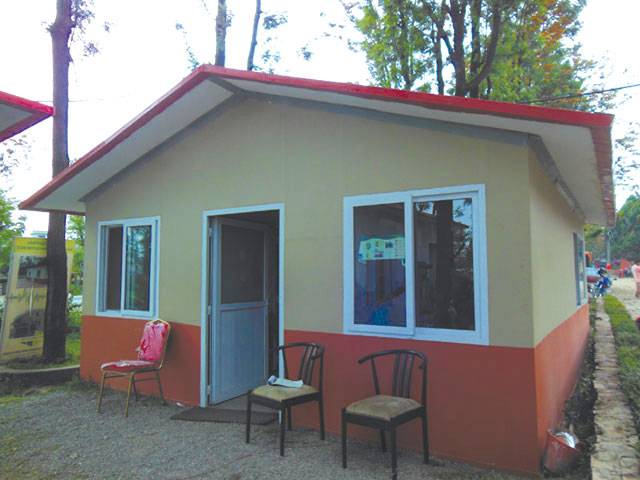TOKYO - After twin earthquakes in April and May claimed 9,000 lives and left vast swathes of Nepal in ruins, survivors worried if they reused the brick rubble, they would end up with the same vulnerable, seismically unsound structures.
Renowned Japanese architect Shigeru Ban - who helped bring global attention to humanitarian architecture and continues to influence fellow architects and disaster-relief workers - devised a solution.
“Each disaster is different, so I have to go there to find out the particular problems to solve,” said 58-year-old Ban, who built paper emergency shelters in Haiti after the 2010 quake and the Philippines after Typhoon Haiyan two years ago.
The prototype for his latest humanitarian housing project in Nepal consists of standard timber door frames joined together and reinforced with plywood. The frames are filled in with brick rubble, and the roof is covered with a plastic sheet and thatched for insulation.
The resulting structure is strong enough to meet Japan’s stringent earthquake standards, he said in an interview at his office in Tokyo.
“I’m hoping people will copy my design. If we make 20, some other NGO might make more. I’m encouraging people to copy my ideas. No copyrights,” Ban said, noting he always tries to enlist the help of his houses’ future inhabitants.
“If they’re involved in the construction, if the structure needs maintenance, they will know how to do it themselves.”
Ban, who in 2014 won the Pritzker Prize, architecture’s top award, has also built shelters for Rwandan refugees in 1994, Sri Lankan survivors of the 2004 tsunami, and victims of major disasters in Japan.
Fellow Pritzker prize winners Thom Mayne and Frank Gehry teamed up with Ban to work with actor Brad Pitt’s Make It Right Foundation, a non-profit group set up in 2007 to help rebuild New Orleans’ Lower 9th Ward after Hurricane Katrina.
Ban’s work has pushed aid agencies to take on challenges differently, said Brett Moore, a shelter, infrastructure and reconstruction advisor for World Vision International. “Ban’s approach to humanitarian work prompts the entire humanitarian community to think outside the box, to reject generic and inappropriate responses to vastly different contexts, and to approach the work with individuality and creativity,” Moore said. His emphasis on reusing materials also fits with a broader trend, as aid agencies try to rebuild sustainably after disasters.
“There’s a lot more concern now than there has been in past decades on reuse and recycling. That is something for us as humanitarian agencies to look into,” said Sandra D’Urzo, who works on shelters and settlements for the International Federation of the Red Cross in Geneva.
While Ban said he enjoys working on grand projects commissioned by privileged people, he also wants to help people who have lost their homes, and is encouraged that many architects have followed in his footsteps.
After the massive 2011 earthquake and tsunami ravaged the Japan’s Tohoku region, Ban noticed an increase in architects on the ground compared to the aftermath of the Kobe quake.
“When I was working in Kobe in 1995, there were no architects in the disaster area, but in Tohoku after the earthquake, there were so many,” he said.
“I’m very happy that now, even young architects and students are interested in what I’m doing, which was not the case 20 years ago.”
After the quakes hit Nepal, Ban said Nepali students in Tokyo and his friends around the world hastened to raise funds for his project.
“It moved rapidly at first, but not as rapidly as I wished because of the local situation,” Ban said, referring to Nepal’s fuel shortage.
Ethnic Madhesi groups, protesting that Nepal’s constitution adopted in September marginalises them, have been blocking trucks from India. The blockade has led to acute shortages of fuel and medicine.
Ban is used to adapting to harsh local conditions when building for disaster victims, and in this case he had to tweak his original prototype.
Instead of constructing the roof frame with his signature cardboard tubes - as he used after the quake in Christchurch, New Zealand, for a cardboard cathedral - the fuel shortages led Ban to make trusses from timber, until factories are up and running and cardboard can be procured again.
His initial goal to build 30 homes in Phatakshila in the Sindhupalchok district in central Nepal in the coming months is moving forward.
Whenever possible, he uses locally available materials, and prefers renewable resources such as timber and paper to concrete and steel.
“The strength of the building itself has nothing to do with the strength of the material. Even a concrete building can be destroyed by an earthquake very easily, but a building made of paper sometimes cannot be destroyed by the earthquake,” he said, sitting in a chair of his own design made of cardboard rods as solid as wooden dowels.
Thursday, April 18, 2024
Famed architect builds quake-proof homes from rubble in Nepal

3:56 PM | March 28, 2024
4:14 PM | March 23, 2024
Stefanos Tsitsipas advances in Barcelona
4:19 PM | April 18, 2024
Met Office predicts more rains across country till April 29
2:51 PM | April 18, 2024
Punjab changes school timings for summer season
1:55 PM | April 18, 2024
Enemies of Pakistan are unable to digest investment in the country: Ataullah Tarar
1:29 PM | April 18, 2024
IHC restores Bushra Bibi's appeal for shifting to Adiala Jail from Bani Gala
1:24 PM | April 18, 2024
Hepatitis Challenge
April 18, 2024
IMF Predictions
April 18, 2024
Wheat War
April 18, 2024
Rail Revival
April 17, 2024
Addressing Climate Change
April 17, 2024
Justice denied
April 18, 2024
AI dilemmas unveiled
April 18, 2024
Tax tangle
April 18, 2024
Workforce inequality
April 17, 2024
New partnerships
April 17, 2024
ePaper - Nawaiwaqt
Advertisement
Nawaiwaqt Group | Copyright © 2024





